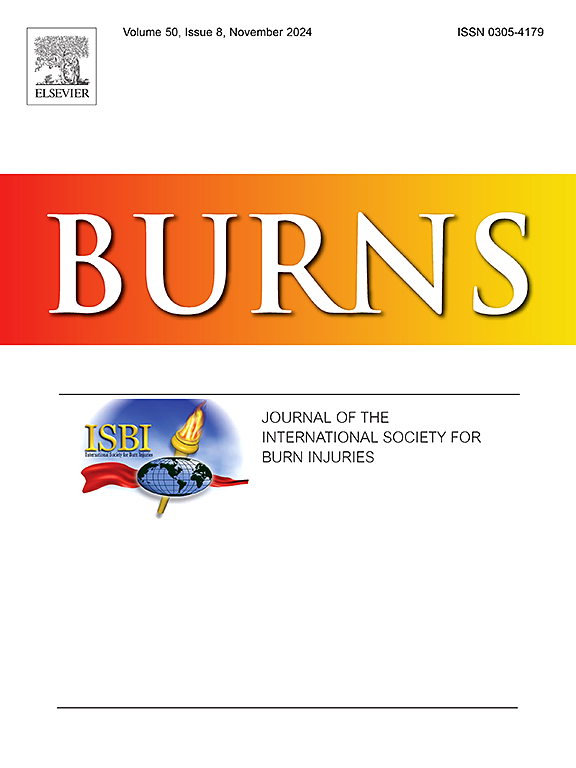一家三级烧伤医院烧伤护理团队成员的职业倦怠、抑郁和焦虑率:一项描述性横断面研究。
IF 3.2
3区 医学
Q2 CRITICAL CARE MEDICINE
引用次数: 0
摘要
背景:在烧伤科工作有其独特的挑战,可能会增加烧伤护理人员的抑郁、焦虑和职业倦怠率。我们旨在估计烧伤护理团队成员的抑郁、焦虑和倦怠率:这项描述性横断面调查于 2024 年 1 月 1 日至 2024 年 2 月 22 日在一家三级烧伤医院进行。研究的测量工具是经过验证的法西语版贝克抑郁量表(BDI)、贝克焦虑量表(BAI)和哥本哈根职业倦怠量表(CBI):我们发现,受访者中抑郁、焦虑和职业倦怠的比例分别为 54.2%、62.7% 和 50.7%。职业倦怠(CBI)、抑郁(BDI)和焦虑(BAI)得分之间呈显著正相关(p 结论:我们的结果表明,有相当数量的受访者在工作中出现了职业倦怠:我们的研究结果表明,相当多的烧伤护理团队成员符合焦虑、抑郁和职业倦怠的标准。焦虑、抑郁和职业倦怠之间的关系呈显著正相关。要减少烧伤护理人员的焦虑、抑郁和职业倦怠,就必须及时采取适当的干预措施。本文章由计算机程序翻译,如有差异,请以英文原文为准。
The rate of burnout, depression, and anxiety among burn care team members in a tertiary burn hospital: A descriptive cross-sectional study
Background
Working in burn units has its unique challenges and may increase the rate of depression, anxiety, and burnout in burn care staff. We aimed to estimate the rate of depression, anxiety, and burnout among the members of the burn care team.
Methods
This descriptive cross-sectional survey was conducted from 1 January 2024 to 22 February 2024 in a tertiary burn hospital. The measurement tools of study were the validated Farsi versions of Beck’s Depression Inventory (BDI), Beck’s Anxiety Inventory (BAI), and Copenhagen Burnout Inventory (CBI).
Results
We found that the rate of depression, anxiety, and burnout was 54.2%, 62.7% and 50.7% in respondents, respectively. The correlation between burnout (CBI), depression (BDI), and anxiety (BAI) scores was significantly positive (p < 0.01). The rate of burnout was significantly higher in younger staff, females, bachelor's degree holders, and burn ICU staff (P < 0.05). Female burn care providers had higher anxiety (P < 0.05). The rate of depression was significantly higher in younger participants and in those with incomes less than 300 dollars .(P < 0.05).
Conclusion
Our results indicated that a significant number of burn care team members met the criteria for anxiety, depression, and burnout. The relationship between anxiety, depression, and burnout was significantly positive. Timely and proper intervention is necessary to reduce anxiety, depression, and burnout in burn care providers.
求助全文
通过发布文献求助,成功后即可免费获取论文全文。
去求助
来源期刊

Burns
医学-皮肤病学
CiteScore
4.50
自引率
18.50%
发文量
304
审稿时长
72 days
期刊介绍:
Burns aims to foster the exchange of information among all engaged in preventing and treating the effects of burns. The journal focuses on clinical, scientific and social aspects of these injuries and covers the prevention of the injury, the epidemiology of such injuries and all aspects of treatment including development of new techniques and technologies and verification of existing ones. Regular features include clinical and scientific papers, state of the art reviews and descriptions of burn-care in practice.
Topics covered by Burns include: the effects of smoke on man and animals, their tissues and cells; the responses to and treatment of patients and animals with chemical injuries to the skin; the biological and clinical effects of cold injuries; surgical techniques which are, or may be relevant to the treatment of burned patients during the acute or reconstructive phase following injury; well controlled laboratory studies of the effectiveness of anti-microbial agents on infection and new materials on scarring and healing; inflammatory responses to injury, effectiveness of related agents and other compounds used to modify the physiological and cellular responses to the injury; experimental studies of burns and the outcome of burn wound healing; regenerative medicine concerning the skin.
 求助内容:
求助内容: 应助结果提醒方式:
应助结果提醒方式:


